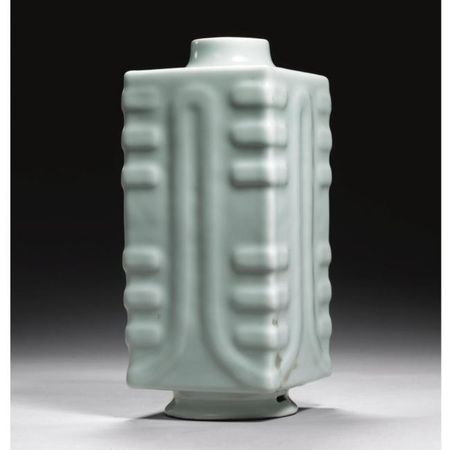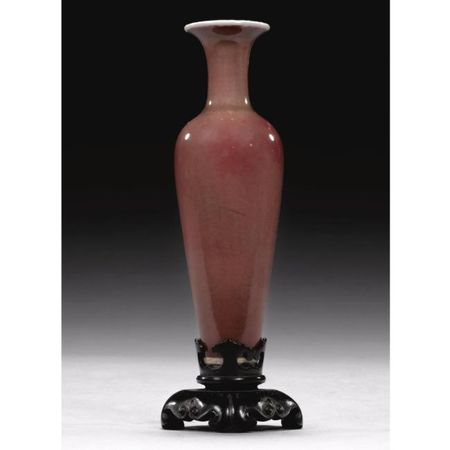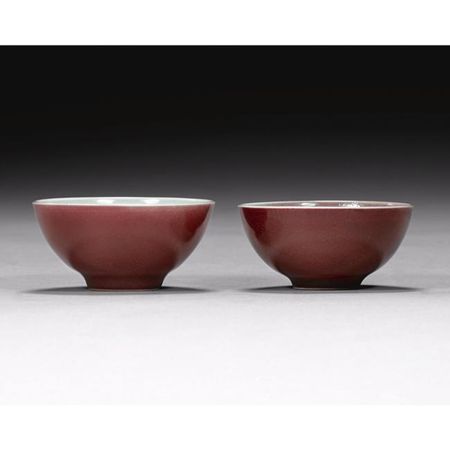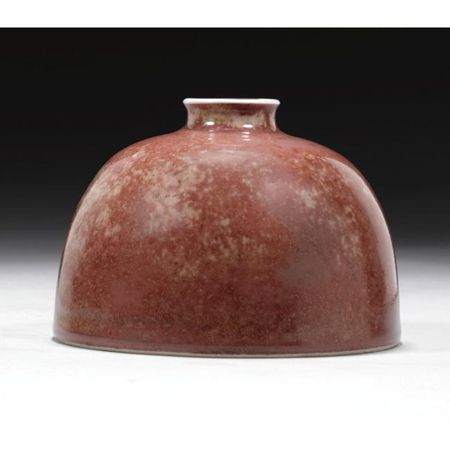A collection of chinese monochromes, Qianlong, Yongzheng, Kangxi, Xuantong & Qing dynasty
A rare ru-type bottle vase. Yongzheng seal mark and period.
the slightly compressed lobed globular body rising from a short tapering foot to a tall waisted neck with inturned flat rim, covered overall with a thick pale bluish-grey glaze. 31.2cm., 12 1/4 in. Est. 80,000—120,000 GBP - Sold 277,250 GBP
NOTE: The present vase is an extremely rare and impressive example of the remarkable development in technique designed to meet the specific predilections of the Yongzheng emperor, among which imitation of the antique and innovation were prominent features. Only one other example appears to have been published, but with broad and darker crackles in the glaze, in the Baur Collection, illustrated in John Ayers, Chinese Ceramics in the Baur Collection, vol. 2, Geneva, 1999, pl. 274. Both pieces possess an internal pierced porcelain armature of cylindrical form to support the heavily potted structure, as vessels of this impressive size stood the risk of collapsing during firing, and highlights the technical virtuosity of potters of this period. The rarity of such a piece is not surprising given the high technical and aesthetic standards demanded of the potters in the imperial manufactories.
From the first year of his reign, the Yongzheng emperor commissioned items from the Palace Workshops, whose output changed in nature as a result. Simplicity of form and absence of decoration were stylistic trends introduced by Tang Ying (1682-1756), Superintendent of the Imperial kilns in Jingdezhen. Under his supervision, research into celebrated Song glazes such as Guan and Ge wares saw the re-emergence of monochrome porcelain covered in luminous pale glazes to simulate the earlier wares on contemporary and unique forms.
In form this piece appears to be an amalgamation of porcelain and bronze vessels. The lobed body with tall trumpet neck appears to have been inspired by Ming dynasty bronze vases, such as one included in the exhibition The Second Bronze Age. Later Chinese Metalwork, Sydney L. Moss Ltd., London, 1991, cat. no. 66. The curling fronds seen on the shoulder and base of the Yongzheng vase may also have their origins in the ruyi lappets found on the bronze vase which have been stylised to endow it with a contemporary twist. In its lobed globular body and stalk-like neck, this piece also resembles contemporary vessels in the shape of fruit such as melons and pomegranates; for a melon-shaped jar covered in a teadust glaze, see one in the Qing Court collection and still in Beijing, illustrated in The Complete Collection of Treasures of the Palace Museum. Monochrome Porcelain, Hong Kong, 1999, pl. 253; and a vase in the shape of a pomegranate glazed to simulate Ru ware, in the National Palace Museum, Taipei, published in the Illustrated Catalogue of Ch'ing Dynasty Porcelain, vol. 1, Tokyo, 1980, pl. 126.
A rare ru-type vase, cong. Qianlong seal mark and period. photo Sotheby's
of archaic jade form, the square section straight-sided body rising from a short spreading circular foot to a narrow tapering circular neck, moulded to each corner with the bagua, the 'Eight Daoist Trigrams', in two tiers framing an undulating raised band, pierced to one side with two pairs of holes for suspension and covered overall in a soft bluish-green glaze. 29cm., 11 3/8 in. Est. 10,000—20,000 GBP - Sold 79,250 GBP
NOTE: A closely related example was sold in our Hong Kong rooms, 16th May 1977, lot 188, again, 21st May 1979, lot 111, and a third time, 20th May 1981, lot 811; and another vase was sold at Christie's London, 16th June 1986, lot 57. A slightly smaller Qianlong vase of this form, but covered in a Ge-type glaze, is illustrated in Sekai toji zenshu, Tokyo, 1956, pl. 94.
The shape of this vase is based on Neolithic ritual jades known particularly from the Liangzhu culture, and was revived in Longquan celadon during the Song dynasty. For a Song prototype, see one from the Baron Hatvany Collection, sold in our Hong Kong rooms, 5th November 1996, lot 605; and another vase of similar form and decoration attributed to the Ming dynasty with a crackled Guan-type glaze, from the Qing Court collection and still in Beijing, published in The Complete Collection of Treasures of the Palace Museum. Monochrome Porcelain, Hong Kong, 1999, pl. 199.
A pair of celadon-glazed dishes. Yongzheng marks and period. photo Sotheby's
each with gently rounded sides rising from a short tapering foot to an everted rim, covered overall in a soft bluish-green glaze, the base glazed white. 13.2cm., 5 1/4 in. Est. 6,000—8,000 GBP - Sold 58,850 GBP
A peachbloom vase, liuyeping. Kangxi mark and period. photo Sotheby's
the elegant slender baluster body rising from a narrow recessed base to a tall trumpet neck with everted rim, covered overall with a peachbloom glaze characteristically thinning to white at the rim, wood stand. 16cm., 6 1/4 in. Est. 8,000—12,000 GBP - Sold 31,250 GBP
A celadon-glazed dish. Yongzheng mark and period. photo Sotheby's
the gently rounded sides rising from a short tapering foot to an everted rim, covered overall in a soft bluish-green glaze, the base glazed white. 13.2cm., 5 1/4 in. Est. 3,000—5,000 GBP - Sold 22,500 GBP
A matched pair of ruby cups. Yongzheng marks and period. photo Sotheby's
each delicately potted body with rounded sides rising from a short tapering foot, the exterior glazed in a rich ruby-red tone, the interior and base white. 7cm., 2 7/8 in. Est. 5,000—7,000 GBP - Sold 18,750 GBP
A ruby enamelled vase, yuhuchunping. Qianlong seal mark and period, enamels possibly later. photo Sotheby's
the pear-shaped body rising from a short tapering foot to a tall trumpet neck, covered overall in a rich raspberry-red enamel, the interior and base glazed white. 28.5cm., 11 1/4 in. Est. 3,000—5,000 GBP - Sold 13,750 GBP
A peachbloom beehive waterpot. Kangxi mark and period. photo Sotheby's
the rounded sides rising to a short neck and slightly everted rim, finely incised around the exterior with three stylised archaistic dragon roundels, covered overall in a peachbloom glaze of varying mottled pink to liver red tones, the base glazed white. 12.7cm., 4 7/8 in. Est. 10,000—15,000 GBP - Sold 11,875 GBP
PROVENANCE: Ernest G. Raphael.
A small pair of celadon-ground 'wu fu' dishes. Qianlong seal mark and period. photo Sotheby's
the steep sloping sides rising to the rims dressed in gilt, the sides of the exterior painted with five bats in blue enamel. 8cm., 3 1/8 in. Est. 3,000—5,000 GBP - Sold 11,250 GBP
PROVENANCE: John Sparks Ltd., London.
A small lavender-glazed dish. Yongzheng mark and period. photo Sotheby's
the rounded sides rising from a short foot, to a slightly everted rim, covered with an even deep lavender glaze. 13.3cm., 5 1/4 in. Est. 2,000—3,000 - Sold 10,000 GBP
A copper-red alms bowl. Qianlong seal mark and period. photo Sotheby's
the slightly compressed globular body rising from a recessed base to an inverted rim and broad mouth, covered around the exterior with a rich red glaze, the interior and base glazed white. 16cm., 7 1/8 in. Est. 3,000—5,000 GBP - Sold 9,375 GBP
A celadon-glazed quatrefoil dish. Qianlong mark and period. photo Sotheby's
the gently rounded lobed sides rising from a short tapering foot, covered overall in a soft bluish-green glaze draining to white at the rim. 7cm., 2 3/4 in. Est. 3,000—5,000 GBP - Sold 6,875 GBP
A pair of imperial yellow saucer dishes. Xuantong marks and period. photo Sotheby's
each with shallow rounded sides rising from a short tapering foot to a gently everted rim, covered inside and out with a rich egg-yolk yellow glaze. 10.8cm., 4 1/4 in. Est. 3,000—5,000 GBP - Sold 5,625 GBP
A 'langyao' bottle vase. Qing dynasty, 18th century. photo Sotheby's
the robustly-potted pear-shaped body rising from a short foot to a tall cylindrical neck, covered overall in a rich lustrous red glaze of crushed raspberry tone draining to a buff tone at the rim. 38cm., 15in. Est. 6,000—8,000 GBP - Sold 4,000 GBP
Sotheby's. Fine Chinese Ceramics and Works of Art. 04 Nov 09. London www.sothebys.com

/https%3A%2F%2Fprofilepics.canalblog.com%2Fprofilepics%2F1%2F0%2F100183.jpg)
















/http%3A%2F%2Fstorage.canalblog.com%2F65%2F69%2F119589%2F65765172_p.jpg)
/http%3A%2F%2Fstorage.canalblog.com%2F70%2F03%2F119589%2F57582267_p.jpg)
/http%3A%2F%2Fstorage.canalblog.com%2F91%2F07%2F577050%2F57137863_o.jpg)
/http%3A%2F%2Fstorage.canalblog.com%2F09%2F09%2F577050%2F57127029_o.jpg)